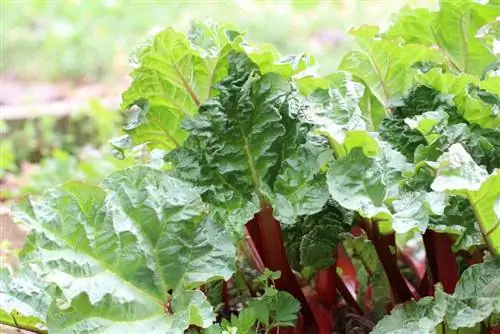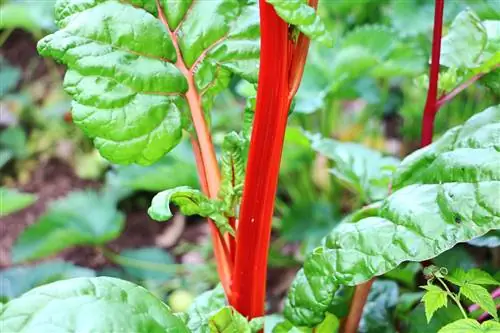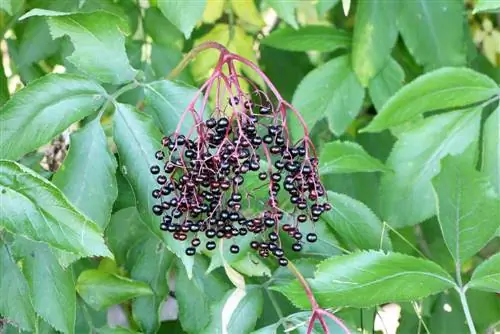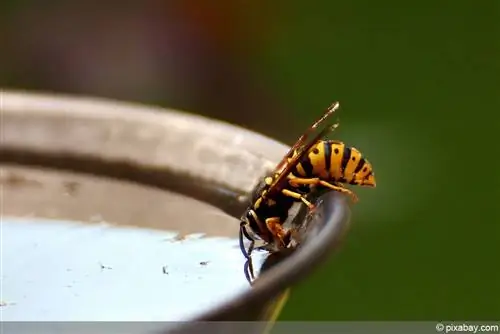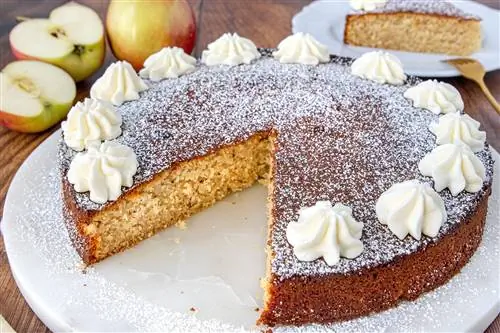- Author admin [email protected].
- Public 2023-12-17 03:39.
- Last modified 2025-01-24 12:45.
If you don't know what to do with the rhubarb sticks and have some time, you should cook rhubarb jam with them. The basic recipe is very simple and there are many aromatic variations. The finished jam can be used in savory cuisine just as well as for desserts and cakes. Rhubarb is available early in the year, from May to half of June. It should then be processed fresh, directly after purchase or harvest.
Rhubarb varieties
The rhubarb varieties can be roughly divided into three main types based on their appearance and taste:
Sticks with green peel and green flesh
These, mostly old varieties, are very fast-growing, extremely productive and often form long, thick stems with huge leaves. Their taste is quite sour. These varieties also contain a lot of oxalic acid. Well-known varieties are: 'Goliath' and 'Gigant'
Bars with reddish skin and green flesh
These varieties are mildly sour, but usually have an intense aroma, comparable to raspberries or strawberries. This has earned the most prominent representative of this variety, the 'Frambozen Rood', the nicknames strawberry, raspberry and rose rhubarb.
Bars with red skin and red flesh
These varieties have a sweet and sour taste. The proportion of fruit acid and oxalic acid is lowest in these varieties. Well-known varieties are 'Holsteiner Edelblut', 'Elmsblitz' and 'Elmsjuwel'.
All types are equally suitable for jam recipes. The decision is purely a matter of taste. The level of sweetness can be adjusted to individual taste when preserving. Anyone suffering from gout, rheumatism, gallstones or kidney stones should choose the red-fleshed variety with the lowest proportion of oxalic acid.
Oxalic acid
Rhubarb is very low in calories (20 kcal/100g) and contains a lot of potassium and vitamin C. The dreaded oxalic acid is also a type of fruit acid and is found in many fruits and vegetables. In the fresh stalks of rhubarb there are approx. 200mg to 760mg per 100g. The proportion varies, sometimes considerably, depending on the variety. However, the largest proportions of oxalic acid are found in the leaves and peel. If you want to be on the safe side, you should peel the stems and blanch them briefly before processing. Then throw away the water. Since rhubarb with its oxalates is considered a calcium robber, it is also recommended to consume rhubarb together with dairy products.
Rhubarb sticks
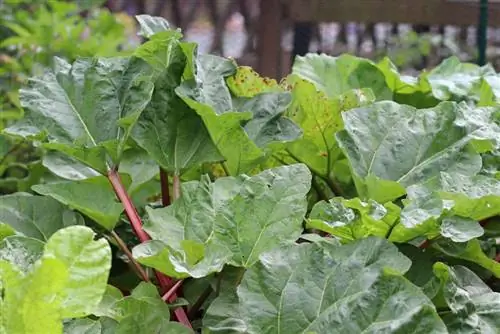
If you have your own rhubarb in your garden, you don't need to worry about the freshness of the stalks. If you rely on what a supermarket or weekly market offers, you should check the sticks before buying. In any case, they must be nice and firm and have a matt shine. The mild, red varieties do not necessarily need to be peeled to make jam.
If you don't have time to cook the rhubarb as jam immediately after harvesting, you can also freeze it. This actually has a positive effect on the color of the jam (if the flesh is red). To do this, you should clean the bars and cut them into pieces. For a good result, first freeze them spread out and then put them together in the freezer bag. It's best to measure it in kilos or half kilos so that you can start making jam at any time and immediately.
Jarling sugar
Another topic is the sweetness of rhubarb jam. There are different types of preserving sugar available in stores. Gelling sugar contains refined sugar, pectin as a gelling agent and usually an acidulant (citric acid, tartaric acid) for shelf life. Depending on the proportion of the vulturating agent pectin, it is declared on the packaging as 1:1, 2:1 and 3:1. The first number describes the proportion of fruit in relation to sugar. A jam will be less sweet if you use the 3:1 preserving sugar. Here the proportion of gelling agent is larger in relation to the sugar. However, the jam no longer lasts as well because of the lower sugar concentration.
Basic recipe
The basic recipe for rhubarb jam is very simple and apart from fresh rhubarb stalks, only three other ingredients are required. The quantity is given as six 250ml glasses and can be converted accordingly for a larger quantity or different glass size.
Ingredients
- 1 kg cleaned rhubarb sticks
- 1 kg preserving sugar 1:1
- 1 vanilla bean
- (3 tbsp lemon juice)
Work steps
- Cut the rhubarb into 1 to 2 cm long pieces.
- Cut the vanilla pod in half lengthways and spread out the pulp with a teaspoon.
- Mix the rhubarb pieces thoroughly with the preserving sugar, the vanilla pulp, the pod halves and the lemon juice.
- Then cover and let the juice steep in the fridge for at least an hour, or even for a whole night.
- During this time the glasses can be prepared.
- Clean the jars and lids thoroughly with boiling water and place them on a clean tea towel.
- After the steeping time, place the pot on the oven and let the mixture boil.
- Let it boil for about five minutes.
- Remove the two vanilla bean halves and pour the mixture into the glasses.
- Screw the lids on and place the jars on the lids for a few minutes.
- Then turn over again and let cool.
Tip:
After cooking for four or five minutes, you can do a gelling test. Simply put a little of the jam on a plate. When it sets, the jam is ready. Otherwise, just let the mixture simmer a little longer.
Storage
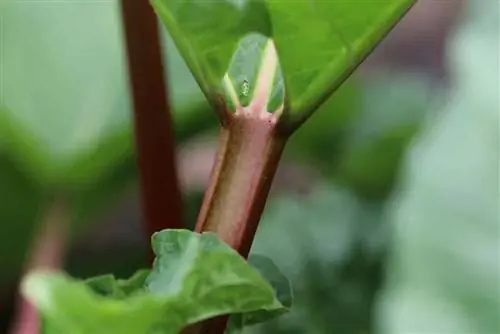
If the jars have been carefully prepared and are sealed airtight, the jam will last for up to two years. A cool, dark room (basement, pantry) is best suited for this. Started jars are best stored in the refrigerator.
Variations
Jam with regular sugar
You can buy normal household sugar in stores, but also so-called preserving sugar. The latter is also normal sugar without gelling agents. It's just much coarser and has better cooking properties than normal household sugar (it doesn't caramelize as quickly). Preparation with table sugar (or preserving sugar) is similar to the basic recipe: one kilo of sugar to one kilo of rhubarb. After a thorough steeping period overnight, just boil the liquid with the sugar until slightly bubbling with the lid open. The rhubarb sections are then cooked in it for the last 10 minutes.
Jam without sugar
If you want to cook your rhubarb jam without sugar, you have several options. Basically, it is then advantageous to use the classic mixture of rhubarb and strawberries. The strawberries fit the aroma perfectly and, above all, bring a bit of fruit sweetness. Rice syrup or stevia can be used as an additional sweetener. It is important to also use a gelling agent, as the sugar or gelling sugar is eliminated.
Gelling agent for jam
- Agar Agar (vegan; made from dried seaweed)
- Pectin, apple pectin (vegan; apple pomace, lemon)
- Carob bean gum (vegan; flour from the seeds of the carob tree)
- Gelatine (should not be used in cooking, but rather for cold fruit spreads or desserts)
Tip:
Be sure to pay attention to the expiry date for gelling agents and also for preserving sugar. After their shelf life has expired, these products increasingly lose their ability to gel.
Jam without anything
Purists can also thicken the pulled rhubarb a little by gently simmering it and pouring the resulting puree into a glass. However, once it has cooled down, it should be kept cool and consumed quickly.
Chutney instead of jam
If you combine rhubarb with ginger and mango or with tomatoes and balsamic vinegar, you will have a spicy version with rhubarb in no time. Chutneys cooked slowly and thoroughly with sugar and vinegar will last up to a year in their sealed jars.
Jam with roasted fruits
The highlight for an extra intense fruit taste: All the ingredients for the jam, for example rhubarb and strawberries, are chopped into small pieces and mixed with sugar and placed on a baking tray. The mixture is allowed to roast for half an hour at 200 °C. But be careful and stir occasionally so that it doesn't burn. Then mash the mixture, if necessary with a potato masher, and fill it into glasses.
Aroma, combinations

If you make your own rhubarb jam, you can get creative with the flavors. Below are a few suitable flavoring agents and combinations for and with rhubarb.
Fruit combinations, rhubarb with
- Strawberries
- Citrus fruits
- elderflower
- Apples
- Raspberries
- Apricots
Flavoring with
- Mint
- Ginger
- Coconut
- Cinnamon
Conclusion
Homemade rhubarb jam on your Sunday roll is a real treat! Rhubarb jam can also be used to spice up the taste of quark, cream and yoghurt. In savory cuisine, rhubarb jam is a sophisticated flavoring agent, for example with game dishes and duck.

